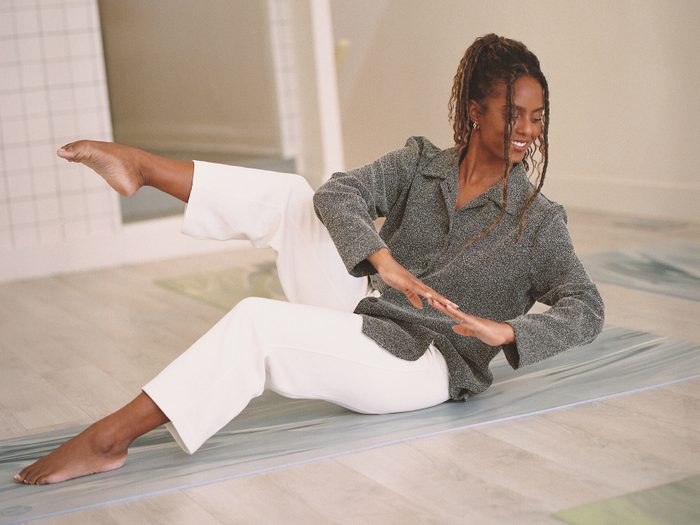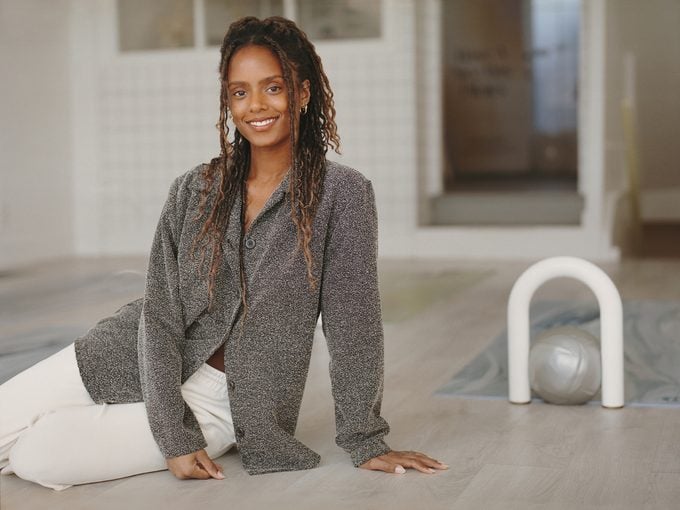Pilates Isn’t Only Good for Your Physical Health—But Your Cognitive Health, Too

The cross-lateral movements in Pilates require mindfulness, making them good for the brain.
Whether it’s a vigorous hike or vinyasa yoga, movement of all sorts can improve our cardio and help our joints, organs, skin and muscles. Most importantly, exercise can help us with daily movement. “I always advocate for mobility first,” says Jennifer Winter, owner and creator of Have a Nice Day Pilates, a studio in downtown Toronto. “I like exercises and movements that promote overall mobility, so you can do things like carry your groceries. We often need a bigger range of motion than we think we do.”
A few years ago, Winter was feeling restless at her desk-bound admin job, so mid-pandemic, she pivoted. Leaning on her professional dance background and more than a decade of Pilates experience, she opened Have a Nice Day Pilates in January 2021, which offers both in-studio classes and on-demand online sessions. She hasn’t looked back.
With the cold weather firmly in place across the country, Winter says focusing on movement is that much more important: “We need to move to help keep our blood flowing!” Beyond day-to-day mobility, Pilates can keep us limber as we age. Studies show that it helps ease postmenopausal lumbar tightness, improves lower back pain and can be a good option to manage osteoporosis and knee osteoarthritis. The benefits extend beyond our bodies: Physical activity helps keep our mental health in tip-top shape and improves cognitive function.
In particular, cross-lateral movements (common in Pilates) may be useful in strengthening the mind-body connection. These include asymmetrical motions (where one side is doing something different than the other) and actions that cross our midline (an invisible divider that splits our body into right and left halves).
“This type of movement switches on our brain,” says Winter. “It helps us focus our awareness of our body in space, also called proprioception, which is a brain function.” These movements usually require more mindfulness—which, over time, has multiple effects on our brain, like increased attention, more efficient sensory processing and more adaptive decision-making. “[Cross-lateral movements] force us to slow down and zoom in on a muscle group or an area that’s in motion. It takes a lot of awareness to understand what’s going on and perform the exercise properly.”
One of Winter’s go-to moves to train the brain is called bird dog. It’s performed on your hands and knees and involves extending and drawing in opposite arms and legs—all while balancing. It engages deep core muscles, and it works the stability in your hips and shoulder and builds strength in the wrists and forearms.
Winter also likes an exercise called dead bug that uses similar muscle groups, but requires even more mental focus. In its simplest form, you lie on your back with your arms and legs sticking up toward the ceiling—like a dead bug—and coordinate extending out your opposite arm and leg (as in, extend your left arm and right leg, then do the same on the other side). Winter makes sure to offer this in her morning classes: “It’s like a little espresso shot. There’s so much that’s going on there, even though it sounds simple.”
Another go-to for Winter is a gentle bicycling motion with your legs while on your back. “It has room to layer movements [in the sequence] as you go, so you can start easy and work your way up,” she says. First, use your abdominals and hip flexors to extend and draw in opposite legs in an asymmetrical movement. Next, to add a layer of physical difficulty, engage the upper abs to lift your head and shoulders. Lastly, you can rotate your upper body and touch opposite elbow to knee. This switches on the internal obliques and adds mental difficulty with a cross-midline action.
Often, the hardest moves are the ones we need to pay very close attention to. “That is the beauty of Pilates,” says Winter. “You need to complete full-range movements to get the benefits, which requires all that much more mental focus.”

Here are some other physical benefits from lateral movements, common in pilates:
Side bend: Reach up and over to one side with both arms, creating compression on the same side. Repeat on the other side. “You might use this folding motion to bend and pick up something, or reach for toilet paper,” Winter says. Plus, compressing one side means lengthening the opposite side. “Lateral lengthening opens up space to breathe deeply.”
Seated twist: Like a side bend, a spinal rotation creates mobility by gently compressing one side of your trunk and lengthening the opposite. In a seated position, gently twist to one side. “A seated spine twist strengthens the abdominal wall, obliques, shoulder stabilizers and hip stabilizers,” Winter says. Take two deep breaths, then return to centre. Repeat on the other side.
Side planks: You can’t haul a load of laundry up the stairs without a bit of muscle. Lie on your side, then prop yourself up on your elbow. Raise your hips up toward the ceiling, and lengthen and strengthen through your legs. Create one long line from your heels to your head and keep your chest open. To make this easier, bend your knees before you lift your hips so you’re in a “half” side plank.
Next: The Benefits of Having an At-Home Pilates Machine




